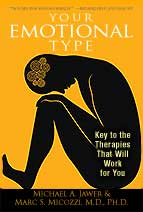Reviews
Your Emotional Type:
Key to the Therapies That Will Work for You
Reviewed by Daniel Redwood, DC
Health Insights Today editorial board member Marc Micozzi, MD, PhD, has co-authored a fascinating new book with Michael Jawer in which they accomplish something rare, utilizing a well-researched method to categorize personality types, using those personality types to understand why certain people get specific illnesses, and then explaining which aspects of complementary and alternative medicine (CAM) can best help these conditions. A former National Cancer Institute researcher who later served as Director of the National Museum of Health and Medicine, and the Center for Integrative Medicine at Thomas Jefferson University Hospital, and has organized the development of dozens of textbooks on various aspects of CAM, Micozzi is superbly qualified to attempt this daunting task, in collaboration with Jawer, an emotion researcher and writer.
Your Emotional Type: Key to the Therapies That Will Work for You, focuses on what the authors call the Dozen Discomforts, twelve chronic illnesses that in most cases are not life-threatening but can profoundly diminish quality of life. Included in the list are asthma and allergies, chronic fatigue syndrome, depression, fibromyalgia, hypertension, irritable bowel syndrome, migraine headache, phantom pain, post-traumatic stress disorder, rheumatoid arthritis, skin conditions such as eczema and psoriasis, and ulcers. Jawer and Micozzi convincingly demonstrate that each of the Dozen Discomforts involves deep-seated interactions between the body and mind and that each poses major challenges for conventional medicine, which struggles to understand these illnesses and craft effective treatments. In many cases, CAM approaches appear to be the best fit for people with these conditions.
Central to Your Emotional Type is the spectrum of boundaries scale developed by psychiatrist Ernest Hartmann of Tufts University, in which personalities are characterized as “thick” or “thin.” This boundary concept provides a practical frame of reference for a variety of health conditions. Based on where someone falls on this thick/thin spectrum, the types of illnesses to which they will be susceptible, as well as the therapies most likely to be helpful, can be discerned. This represents a form of personalized medicine, and differs from the genetically-based “personalized medicine” that many in conventional medicine believe holds the promise of future breakthroughs. Unlike the genomic version, the method presented by Jawer and Micozzi is available now and not focused on creating individualized pharmaceutical drugs or “fingerprinting” someone’s DNA.
In Hartmann’s thick/thin model, thin boundary people are “highly sensitive in a variety of ways from an early age. They react more strongly than other individuals to sensory stimuli and can become agitated when exposed to bright lights, to loud sounds, or to particular aromas, tastes and textures. They respond more strongly to physical and emotional pain in themselves as well as in others. They can become stressed or fatigued due to an overload of sensory or emotional input. They’re more allergic, and their immune systems are seemingly more reactive.”
In contrast, thick boundary people are described “as stolid, rigid, implacable, or thick-skinned. They tend to brush aside emotional upset in favor of simply ‘handling’ the situation and maintain a calm demeanor. In practice, they suppress or deny strong feelings. They may experience an ongoing sense of ennui, of emptiness and detachment. Experiments show, however, that thick boundary people don’t actually feel their feelings any less. Bodily indicators (heart rate, blood pressure, blood flow, hand temperature, muscle tension) betray their considerable agitation despite surface claims of being unruffled.”
Examples of the Dozen Discomforts and their relation to the thick/thin model include chronic fatigue syndrome and rheumatoid arthritis as thick illnesses, while irritable bowel syndrome, seasonal allergies and allergic eczema correspond to the thin boundary type. Most importantly, Jawer and Micozzi explain how and why these and the other conditions correspond to the thick or thin types, using illustrative case studies along with substantial research documentation. Also, as mentioned earlier, this is more than an academic exercise – they point the reader in the direction of helpful CAM therapies.
Your Emotional Type is a valuable contribution to the healing arts and self-care literature. Along with their previous book, The Spiritual Anatomy of Emotion, it deserves a wide readership.
“Daniel Redwood, DC, the interviewer, is a Professor at Cleveland Chiropractic College–Kansas City. He is the Editor-in-Chief of Health Insights Today, where this review was first published, and also serves as Associate Editor of Topics in Integrative Healthcare and on the editorial board of the Journal of the American Chiropractic Association. Dr. Redwood’s website and health policy blog are at www.redwoodhealthspeak.com
Take the on-line questionnaire to find out your emotional boundary type.

